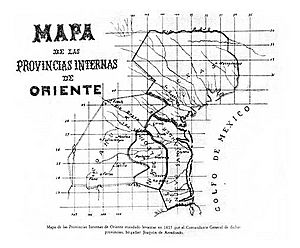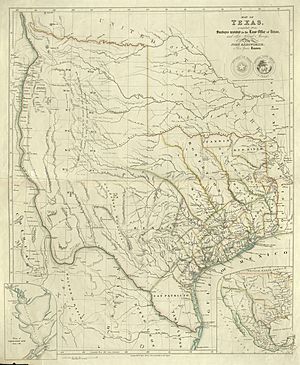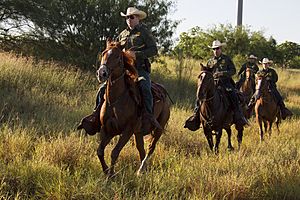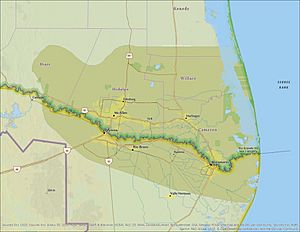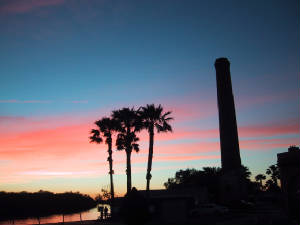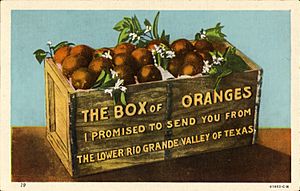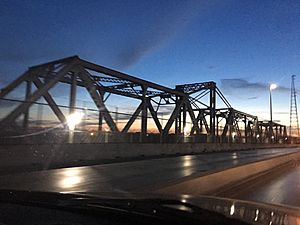Lower Rio Grande Valley facts for kids
Quick facts for kids
Lower Rio Grande Valley
|
|
|---|---|
|
Region
|
|
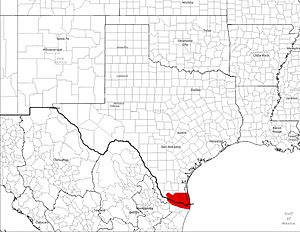
Map of the Lower Rio Grande Valley
|
|
| Country | United States Mexico |
| State | Texas Tamaulipas |
| Principal cities | United States: Brownsville, Harlingen, Weslaco, Donna, Pharr, McAllen, Edinburg, Mission, San Juan, Rio Grande City Mexico: Matamoros, Río Bravo, Reynosa |
| Largest city | Reynosa |
| Area | |
| • Land | 12,620 km2 (4,872 sq mi) |
The Lower Rio Grande Valley (Spanish: Valle del Río Grande), often called the Rio Grande Valley or just the Valley, is a special area along the border of Texas and Mexico. It's located in a flat, low-lying area (a floodplain) near where the Rio Grande river meets the sea.
This region includes the very southern part of South Texas and a piece of northern Tamaulipas, Mexico. It has several important cities like Brownsville, McAllen, and Edinburg in the United States. On the Mexican side, you'll find cities like Matamoros and Reynosa. Many smaller communities called colonias are also part of the Valley.
People here often speak both English and Spanish. Sometimes they even mix the two, creating Spanglish, because of the area's rich history. During winter, many "winter Texans" visit from colder northern states to enjoy the warm weather.
Contents
History of the Rio Grande Valley
Early Peoples and Spanish Arrival
Before Europeans arrived, native peoples lived in small tribes in this area. These tribes in South Texas were mostly hunter-gatherers, meaning they moved around to find food. They were known as the Coahuiltecan people. Old digging sites near Brownsville show that these early people traded shells, even long ago.
The Spanish found it hard to take over this region because of the many different native languages. So, they first focused on the coast of the Gulf of Mexico, which they called the Seno Mexicano. There was also a big argument among Spanish leaders about who would get to colonize the area.
Spanish Settlements and Independence
The first towns, or villas, in the region were started in Laredo and Reynosa in 1767. In 1805, the Spanish government officially set the borders for the territory of Nuevo Santander. This area stretched from the Nueces River in Tejas south to Tampico.
The local government faced many challenges, including wars with native groups, until 1812. After Mexico won its independence from Spain in 1821, the state was renamed Tamaulipas.
Texas Revolution and U.S. Annexation
The Texas Revolution (1835-1836) meant that most of what is now the Rio Grande Valley became part of Texas, though Mexico still claimed it. This area also became a path for enslaved people escaping to Mexico for freedom.
In 1844, the United States, led by President James K. Polk, decided to make the Republic of Texas a U.S. state. This decision angered both Britain and Mexico and helped start the Mexican–American War. Many important battles happened along the Rio Grande, including the Battle of Resaca de la Palma near Brownsville.
The war ended in 1848 with the Treaty of Guadalupe Hidalgo. This treaty set the Rio Grande as the southern border of the United States. Because of this change, many people from Tamaulipas moved to the U.S. side of the river. After the war, the Valley's population grew, and farmers started raising cattle. However, conflicts over land between native peoples and white settlers continued until the 1920s.
Early 1900s and the Mexican Revolution's Impact
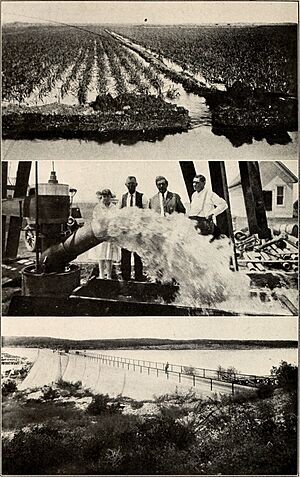
Around 1900, trade and movement between Mexico and the U.S. were common. The arrival of the St. Louis, Brownsville and Mexico Railway in 1903 and new ways to water crops from the Rio Grande helped the Valley become rich farmland.
However, droughts in the late 1800s and early 1900s caused smaller farmers to lose their land. Wealthy newcomers, who arrived by train, bought this land. This led to many Tejanos (Texans of Mexican heritage) losing their ranches.
Meanwhile, the Mexican Revolution was happening in Mexico. The fighting sometimes crossed the border, with groups raiding for supplies. To respond, President Taft sent the United States Army to the region from 1911 to 1916. Texas Governor Oscar Branch Colquitt also sent the Texas Rangers to keep peace between Mexicans and Americans.
The region saw several conflicts, including reactions to the Plan of San Diego, and violence caused by racial tensions. In 1921, the United States Border Patrol started in the region with only a few officers. At first, they focused on trade and stopping alcohol smuggling during Prohibition. Later, they began to focus on stopping illegal crossings.
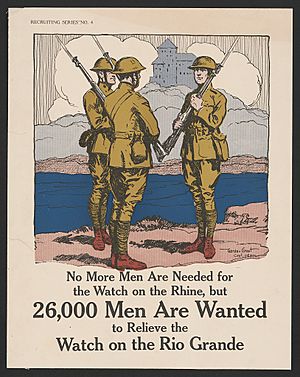
The number of Border Patrol agents increased a lot during World War I because of concerns like the Zimmermann Telegram. The Texas Rangers also increased their presence. During World War II, there were two major military training bases in Brownsville and Harlingen.
Modern Times: Trade and Border Changes
The North American Free Trade Agreement (NAFTA) was created in 1994. It was a trade deal between the United States, Mexico, and Canada. NAFTA aimed to boost trade by lowering or removing taxes on Mexican goods. As a result, exports and imports in the region tripled.
The Rio Grande Valley benefited from NAFTA in retail, manufacturing, and transportation. More jobs and trade led many people to move to the RGV. In 2018, the Trump Administration replaced NAFTA with a new agreement called the United States–Mexico–Canada Agreement (USMCA).
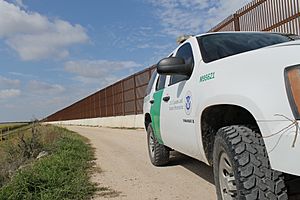
After the September 11 attacks, the U.S. set up United States Border Patrol interior checkpoints at the north end of the Rio Grande Valley. These checkpoints act as a second line of defense against smuggling.
More recently, the organization "We Build The Wall" started building a section of the border wall in the Valley. Local people have worried about this project, especially its closeness to the National Butterfly Center and the Rio Grande, which can flood seasonally. The International Boundary and Water Commission has asked "We Build The Wall" to stop construction until they can check if it breaks a treaty signed in 1970.
Geography of the Valley
The Rio Grande Valley isn't actually a true valley with mountains on both sides. It's a river delta, which is a flat area of land formed by a river depositing soil as it flows into a larger body of water. The name "Valley" is often used in the western U.S. for large flat areas with rivers, especially those good for farming.
In the early 1900s, land developers called it "Magic Valley" to attract new settlers and investors. People who live here often call it El Valle, which is Spanish for "the valley." The main part of the region is in four Texas counties: Starr County, Hidalgo County, Willacy County, and Cameron County.
Major Cities and Towns
The biggest city on the U.S. side is Brownsville (in Cameron County), followed by McAllen (in Hidalgo County). Other important cities include Harlingen, Edinburg, and Mission. On the Mexican side, Matamoros, Río Bravo, and Reynosa are major cities in this region.
People and Culture
Population and Background
As of 2012, about 1.3 million people lived in the U.S. part of the Rio Grande Valley. The U.S. Census Bureau reported in 2008 that a large majority of people in the Valley's counties are Hispanic. For example, 90% of Hidalgo County is Hispanic.
Colonias: Rural Communities
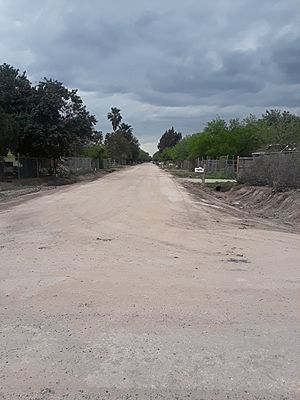
Around the main cities in the Rio Grande Valley are smaller rural communities called colonias. These communities are mostly home to poorer Hispanic families. They often don't have basic services like proper sanitation and sewage systems, and they can suffer from flooding. Many homes in colonias are mobile homes or houses built by the residents themselves.
The Bracero program in the 1940s allowed Mexican workers to cross the border to work in farms. Many came to the Rio Grande Valley. Because there weren't enough affordable homes, developers sold them land in undeveloped areas. Over time, these groups of homes became known as colonias. Today, about 1.6 million people live in 1,500 recognized colonias along the U.S.-Mexico border.
Language Use
People in the Lower Rio Grande Valley usually speak both English and Spanish. They often mix the two languages, creating Spanglish, depending on who they are talking to and where they are.
The Spanish language is very important in daily life. In 1982, most people in the Rio Grande Valley spoke Spanish. People use Spanish for everything, including business, government, and at home. When dealing with government officials, many people prefer to speak Spanish, as seen during the region's 2018 flooding.
| Cameron
County |
Hidalgo
County |
Starr
County |
Willacy
County |
|
|---|---|---|---|---|
| Population 5 years and older | 384,007 | 759,143 | 56,972 | 20,442 |
| Speaks English only | 102,074 | 119,489 | 2,072 | 8,252 |
| Language other than English | 281,933 | 639,654 | 54,900 | 12,190 |
| Spanish | 278,451 | 631,638 | 54,838 | 12,005 |
| Other Indo-European Languages | 1,302 | 2,126 | 3 | 155 |
| Asian and Pacific Islander Languages | 1,511 | 5,460 | 53 | 22 |
| Other Languages | 669 | 430 | 6 | 8 |
Religion in the Valley
The Catholic Church has been in the Rio Grande Valley since the Spanish first arrived. In San Juan, Texas, the Basilica of the National Shrine of Our Lady of San Juan del Valle is a very important Catholic church and pilgrimage site.
Besides Catholicism, many other Christian churches are in the Valley. There are also communities of Sikh, Muslim, Hindu, Jewish, Buddhist, and Baháʼí Faith followers.
Climate and Weather
The Lower Rio Grande Valley has a warm and pleasant climate, which attracts many visitors. Temperatures can get very hot in the summer, sometimes over 100 degrees Fahrenheit. In winter, it can get cold enough to freeze, but this is rare, especially near the coast, which has a tropical climate. While the Valley has had severe cold events, like the 2004 Christmas snow storm and 2021 cold snap, freezing temperatures are not common.
Because it's close to the Gulf of Mexico, the region can be hit by hurricanes. Although not as often as other parts of the Gulf Coast, the Valley has experienced major hurricanes. Past hurricanes include Hurricane Beulah (1967), Hurricane Allen (1980), Hurricane Gilbert, Hurricane Bret, Hurricane Dolly (2008), Hurricane Alex (2010), and Hurricane Hanna (2020). Since the land is very flat, hurricanes usually cause a lot of flooding in the Valley.
Tourism and Attractions
The Lower Rio Grande Valley has many places that attract tourists. Popular spots include the Laguna Atascosa National Wildlife Refuge, Santa Ana National Wildlife Refuge, Bentsen-Rio Grande Valley State Park, South Padre Island, and the Port Isabel Lighthouse.
The Valley is also a popular stop for tourists visiting northeast Mexico. Across the border, popular places to visit include Matamoros, Nuevo Progreso, and Reynosa, all in the Mexican state of Tamaulipas. The region also attracts visitors from other Mexican states like Nuevo León and Coahuila, and from Mexico City.
Historical Places to Visit
- Basilica of the National Shrine of Our Lady of San Juan del Valle
- First Lift Station
- Laguna Atascosa National Wildlife Refuge
- Santa Ana National Wildlife Refuge
- Hugh Ramsey Nature Park
- Los Ebanos Ferry, the last hand-operated ferry on the Rio Grande
- La Lomita Historic District
- Fort Brown
- Palo Alto Battlefield National Historic Site
- Resaca de la Palma
- Rancho de Carricitos
- USMC War Memorial original plaster model, at the Marine Military Academy in Harlingen
- Museum of South Texas History, which used to be the County Court House and Jail
- Battle of Palmito Ranch, where the last battle of the Civil War happened
Economy and Jobs
The Valley's economy has historically relied on agribusiness (farming) and tourism. Important crops include cotton, grapefruit, sorghum, maize (corn), and sugarcane. The region is a major center for growing citrus fruits and vegetables in Texas.
In recent decades, many factories called maquiladoras have opened along the border. These factories have led to a lot of industrial growth. International bridges allow people from Mexico to shop, sell, and do business in the U.S. border cities.
South Padre Island is also part of the Valley and brings in many tourists, especially during Spring Break. Its warm, subtropical climate keeps temperatures pleasant all year. In winter, many retired people, called "Winter Texans," come to enjoy the warm weather and access to healthcare in Mexican border towns like Nuevo Progreso. There's also a large healthcare industry with hospitals and clinics in Brownsville, Harlingen, and McAllen.
Texas is the third-largest producer of citrus fruit in the U.S., and most of it comes from the Rio Grande Valley. Grapefruit makes up over 70% of the Valley's citrus crop. Other fruits grown here include oranges, tangerines, tangelos, and Meyer lemons, harvested each winter.
The Valley also has professional sports teams like the Rio Grande Valley Vipers (basketball) and Rio Grande Valley FC Toros (soccer).
One of the Valley's main attractions is its semi-tropical wildlife. Many different birds and butterflies attract a large number of visitors every year. This "ecotourism" is a big part of the economy in the Rio Grande Valley.
Transportation
The Valley International Airport serves the Rio Grande Valley. It has flights from seven passenger airlines and two cargo airlines, including one international passenger airline, Mexico's VivaAerobus.
Several bus lines operate on the U.S. side of the Valley, such as Metro Connect in McAllen and Brownsville Metro. On the Mexican side, there are many bus companies like Greyhound and Futura.
The Interstate Highway System in the U.S. is well-developed in the Lower Rio Grande Valley. It connects cities like Brownsville, McAllen, and Edinburg. On the Mexican side, there are major highways between Matamoros, Reynosa, and Nuevo Laredo. As of 2015[update], car travel on the Mexican side was sometimes considered risky, and the Mexican Federal Police offered escorts between certain cities.
Freight trains run between Harlingen, Mission, and Edinburg, connecting to the Union Pacific Railroad. In Mexico, Kansas City Southern de México runs freight service and crosses from Matamoros into Brownsville over the Brownsville & Matamoros International Bridge.
Sea trade happens through the deepwater port, the Port of Brownsville, and the Foreign Trade Zone 62.
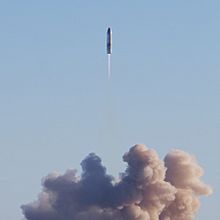
The SpaceX South Texas launch site is located near Brownsville. Elon Musk is also building a special ocean spaceport called Deimos for future trips to and from Mars.
Education
Education in the Rio Grande Valley has faced challenges over time. In the early 1900s, schools were racially separated. A 1940 study showed a need to better teach students from different cultures. The Texas Supreme Court in Del Rio ISD v. Salvatierra supported this separation.
In 1968, President Lyndon B. Johnson signed the Bilingual Education Act. This law helped students whose first language was not English by giving money to local schools for bilingual programs. This helped Mexican students join schools with white students. Texas still has this bilingual program, which is especially helpful for students under the Deferred Action for Childhood Arrivals program.
Colleges and universities in the Rio Grande Valley include:
- Texas A&M Health Science Center, School of Public Health - McAllen
- Texas A&M University - McAllen Campus
- University of Texas Rio Grande Valley — This university started in 2015 when the University of Texas at Brownsville and the University of Texas–Pan American joined together.
- University of Texas Rio Grande Valley School of Medicine
- Texas Southmost College
- Texas State Technical College
- South Texas College
- University of Texas Health Science Center - Regional Academic Health Center
Sports Teams
| Club | Sport | League | Venue | Capacity |
|---|---|---|---|---|
| Rio Grande Valley FC Toros | Soccer | USLC | H-E-B Park | 9,735 |
| Rio Grande Valley Vipers | Basketball | NBA G League | Bert Ogden Arena | 9,000 |
| RGV Barracudas FC | Indoor Soccer | MASL | Payne Arena | 6,800 |
| UTRGV Basketball Men | NCAA Division I Basketball | WAC | UTRGV Fieldhouse | 2,500 |
Hospitals
- Cornerstone Regional Hospital, Edinburg, Texas
- Edinburg Children's Hospital, Edinburg, Texas
- Edinburg Regional Medical Center, Edinburg, Texas
- Doctors Hospital at Renaissance, Edinburg, Texas
- Harlingen Medical Center, Harlingen, Texas
- McAllen Heart Hospital, McAllen, Texas
- McAllen Medical Center, McAllen, Texas
- Rio Grande Regional Hospital, McAllen, Texas
- Rio Grande State Hospital, Harlingen, Texas
- Solara Hospital, Harlingen, Texas
- VA Health Care Center at Harlingen. Harlingen, Texas
- Valley Baptist Medical Center, Harlingen, Texas
- Valley Baptist Medical Center, Brownsville, Texas
- Valley Regional Medical Center, Brownsville, Texas
- Knapp Medical Center, Weslaco, Texas
- Mission Regional Medical Center, Mission, Texas
Media
Magazines
- The Go Guide
- Rio Grande Magazine
- Viva el Valle
- RGV Drives Magazine
- RGVision Magazine
Newspapers
- Valley Town Crier
- The Edinburg Review
- Valley Bargain Book
- El Periódico USA
- El Nuevo Heraldo
- Mega Doctor News
- Texas Border Business
- The Brownsville Herald
- The Island Breeze
- The Monitor
- Valley Morning Star
- Valleywood Magazine
- The Donna News
- Weslaco World
- La Feria Journal
- South Padre Island Post
Television Channels
- KGBT-TV/DT channel 4, Antenna TV Affiliate
- KRGV-TV/DT Channel 5 News, ABC Affiliate
- KVEO-TV/DT News Center 23/CBS 4 (DT-2), NBC/CBS Affiliate
- KCWT-CD 21, The CW Affiliate
- KTFV-CD 32, UniMás Affiliate
- KFXV TV/DT 60, FOX Affiliate
- KLUJ-TV/DT 44, TBN Affiliate
- KTLM-TV/DT 40, Telemundo Affiliate
- KNVO TV/DT 48, Univision Affiliate
- KMBH-LD 67, Fox 2 News, Fox Affiliate
- XERV-TDT 9.1 Las Estrellas, Televisa
- XHAB-TDT 8.1 Vallevision, Televisa
- XHOR-TDT 14.1 Azteca 7, TV Azteca
- XHREY-TDT1.1 Azteca Uno, TV Azteca
Radio Stations
- BLASST Blistering Listens and Strange Sounds, Thank You (Rock, Punk, Hip-Hop, Electronic, Experimental, Ambient, & more)
- KBFM Wild 104 (Hip Hop/Top 40 - IHeart Media)
- XEEW-FM Los 40 Principales 97.7 (Top 40 Spanish/English)
- KBTQ 96.1 Exitos (Spanish Oldies) Univision
- KCAS 91.5 FM (Christian, Teaching/Preaching/Music)
- KESO 92.7 KESO (Classic Hits)
- KFRQ Q94.5 The Rock (Classic Rock) (All Rock All The Time)
- KGBT 1530 La Tremenda (Univision)
- KGBT-FM 98.5 FM (Regional Mexican) Univision
- KHKZ Kiss FM 105.5 & 106.3 (Hot Adult Contemporary)
- KIRT 1580 AM Radio Imagen (Variety, Spanish contemporary)
- KIWW (Spanish)
- KJAV Ultra 104.9 Sonamos Differente (Spanish AC & English HAC) (AC)
- KKPS Fuego 99.5 (Spanish Hot AC (International hits)
- KJJF/KHID 88.9/88.1 Religious (Relevant Radio)
- KNVO-FM La Suavecita 101.1 (Spanish Hits)
- KQXX Kiss FM 105.5 & 106.3 (Hot Adult Contemporary, simulcast of KHKZ - IHeart Media)
- KTEX 100.3 (Mainstream Country - IHeart Media)
- KURV 710 AM Heritage Talk Radio (part of the BMP family of stations)
- KVLY 107.9 RGV FM (AC) (More Hits, More Variety)
- KVMV 96.9 FM (Christian, Contemporary Music) World Radio Network
- KVNS 1700AM (Fox Sports Radio - IHeart Media)
- XHRYA-FM 90.9 Mas Music (Spanish/English Mix)
- KBUC Super Tejano 102.1 (Tejano)
Notable People from the Valley
Many famous people were born, lived, or passed away in the Rio Grande Valley, including:
- Abraham Ancer (professional golfer, Olympian)
- Ramón Ayala (singer)
- David V. Aguilar (Chief Border Patrol Agent)
- Cristela Alonzo (comedian, actress)
- Micaela Alvarez (federal judge)
- Natalia Anciso (contemporary artist)
- Gloria E. Anzaldúa (writer, poet)
- Cathy Baker (television performer)
- Lloyd Bentsen (U.S. Secretary of the Treasury; U.S. Senator)
- James Carlos Blake (novelist)
- Harlon Block (Iwo Jima flag raiser)
- William S. Burroughs (writer)
- Pedro Cano (Medal of Honor recipient)
- Rolando Cantú (football player)
- Raúl Castillo (actor)
- Thomas Haden Church (actor)
- Freddy Fender (actor, musician)
- Mike Fossum (astronaut)
- Reynaldo Guerra Garza (federal judge)
- Kika de la Garza (U.S. Representative)
- Roberto Garza (football player)
- Xavier Garza (author and illustrator)
- Tony Garza (U.S. Ambassador to Mexico)
- Alfredo C. Gonzalez (Medal of Honor Recipient)
- Matt Gonzalez (2008 Vice-Presidential candidate)
- Esteban Jordan (accordionist)
- Bill Haley (musician)
- Catherine Hardwicke (film director-producer)
- Rolando Hinojosa (author)
- Rubén Hinojosa (U.S. Representative)
- Kris Kristofferson (musician, actor)
- Tom Landry (American football coach)
- Bobby Lackey (College Football Player)
- José M. López (Medal of Honor Recipient)
- Domingo Martinez (author)
- Eduardo Martinez (Historian, Journalist)
- Roy Mitchell-Cárdenas (musician)
- Jack Morava (mathematician)
- Rachel McLish (Ms. Olympia; actress)
- Bobby Morrow (Olympic gold medalist)
- Billy Gene Pemelton (1964 Olympian)
- Major Samuel Ringgold (father of modern artillery)
- Charles M. Robinson III (author)
- Valente Rodriguez (actor)
- Ricardo Sanchez (U.S. Army lieutenant general)
- Julian Schnabel (filmmaker)
- Adela Sloss Vento
- Merced Solis aka Tito Santana (wrestler)
- Nick Stahl (actor)
- Emeraude Toubia (actress)
- Filemon Bartolome Vela (federal judge)
- Eric Miles Williamson (novelist, professor)
- Raquel Gonzalez (wrestler)
Images for kids
-
A dirt road in a colonia near Edinburg, Texas
See also
 In Spanish: Valle del Río Grande para niños
In Spanish: Valle del Río Grande para niños



